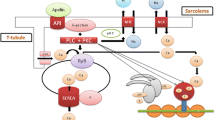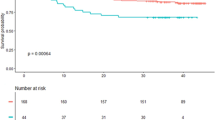Abstract
To date, only animal studies have been concerned with apelin involvement in acute myocardial ischemia. The aim of this study was to investigate apelin measurements in low-risk patients with first ST-elevation myocardial infarction (STEMI) and to assess if apelin may feature as a marker of left ventricular (LV) injury and prognosis. In 78 consecutive patients (mean age 67 ± 11.5 years, 24 women) with first STEMI treated with primary percutaneous coronary intervention, plasma apelin-36 concentrations were measured twice: on admission and on the 5th day of hospitalization. Left ventricle ejection fraction (LVEF) was applied as marker of LV injury. Composite endpoint (CEP), which included death, stroke, and recurrent ischemic event, was assessed after 1 year follow-up. On the first day, median apelin-36 concentration was 2138.5 pg/ml and on the 5th day was significantly lower, 2008.3 pg/ml (P = 0.002). There were no significant differences found in apelin-36 concentrations between patients with normal and low LVEF. In both groups significant reductions were found in apelin-36 concentrations measured in 5-day intervals (P = 0.04 and P = 0.008, respectively). After a 1-year follow-up, only one patient died and 19 patients (24.3%) had reached CEP. No difference in baseline apelin-36 concentrations were found in the group of patients who reached CEP compared with those without CEP. However, in both groups concentrations significantly decreased after 5 days (P = 0.04 and P = 0.013, respectively). Apelin-36 concentrations are reduced in lowrisk first STEMI patients during the first days regardless of the degree of LV dysfunction and prognosis.
Similar content being viewed by others
References
Chandrasekaran B, Dar O, McDonagh T (2008) The role of apelin in cardiovascular function and heart failure. Eur J Heart Fail 10:725–732
Chong KS, Gardner RS, Morton JJ, Ashley EA, McDonagh TA (2006) Plasma concentrations of the novel peptide apelin are decreased in patients with chronic heart failure. Eur J Heart Fail 8:355–360
De Mota N, Reaux-Le Goazigo A, El-Messari S, Chartrel N, Roesch D, Dujardin C, Kordon C, Vaudry H, Moos F, Llorens-Cortes C (2004) Apelin, a potent diuretic neuropeptide counteracting vasopressin actions through inhibition of vasopressin neuron activity and vasopressin release. Proc Natl Acad Sci USA 101: 10464–10469
Ronkainen VP, Ronkainen JJ, Hänninen SL, Leskinen H, Ruas JL, Pereira T, Poellinger L, Vuolteenaho O, Tavi P (2007) Hypoxia inducible factor regulates the cardiac expression and secretion of apelin. FASEB J 21:1821–1830
Goetze JP, Rehfeld JF, Carlsen J, Videbaek R, Andersen CB, Boesgaard S, Friis-Hansen L (2006) Apelin: a new plasma marker of cardiopulmonary disease. Regul Pept 133:134–138
Dagli N, Ozturk U, Karaca I, Yavuzkir M, Koca S, Akbulut H, Balin M (2009) Adiponectin levels in coronary artery ectasia. Heart Vessels 24:84–89
Selcuk H, Selcuk MT, Temizhan A, Maden O, Saydam GS, Ulupinar H, Dogan M, Aydin C, Topcu DI, Sasmaz A (2009) Decreased plasma concentrations of adiponectin in patients with slow coronary flow. Heart Vessels 24:1–7
Berry MF, Pirolli TJ, Jayasankar V, Burdick J, Morine KJ, Gardner TJ, Woo YJ (2004) Apelin has in vivo inotropic effects on normal and failing hearts. Circulation 110(11 suppl 1):II187–II193
Japp AG, Cruden NL, Amer DA, Li VK, Goudie EB, Johnston NR, Sharma S, Neilson I, Webb DJ, Megson IL, Flapan AD, Newby DE (2008) Vascular effects of apelin in vivo in man. J Am Coll Cardiol 52:908–913
Weir RA, Chong KS, Dalzell JR, Petrie CJ, Murphy CA, Steedman T, Mark PB, McDonagh TA, Dargie HJ, McMurray JJ (2009) Plasma apelin concentration is depressed following acute myocardial infarction in man. Eur J Heart Fail 11:551–558
Miettinen KH, Magga J, Vuoltenaho O, Vanninen EJ, Punnonen KR, Ylitalo K, Tuomainen P, Peuhkurinen KJ (2007) Utility of plasma apelin and other indices of cardiac dysfunction in the clinical assessment of patients with dilated cardiomyopathy. Regul Pept 140:178–184
Codognotto M, Piccoli A, Zaninotto M, Mion M, Vertolli U, Tona F, Boffa GM (2007) Evidence for decreased circulating apelin beyond heart involvement in uremic cardiomyopathy. Am J Nephrol 27:1–6
Malyszko J, Malyszko JS, Kozminski P, Mysliwiec M (2006) Apelin and cardiac function in hemodialyzed patients: possible relations? Am J Nephrol 26:121–126
Chen MM, Ashley EA, Deng DX, Tsalenko A, Deng A, Tabibiazar R, Ben-Dor A, Fenster B, Yang E, King JY, Fowler M, Robbins R, Johnson FL, Bruhn L, McDonagh T, Dargie H, Yakhini Z, Tsao PS, Quertermous T (2003) Novel role for the potent endogenous inotrope apelin in human cardiac dysfunction. Circulation 108:1432–1439
Francia P, Salvati A, Balla C, De Paolis P, Pagannone E, Borro M, Gentile G, Simmaco M, De Biase L, Volpe M (2007) Cardiac resynchronization therapy increases plasma levels of the endogenous inotrope apelin. Eur J Heart Fail 9:306–309
Simpkin J, Yellon DM, Davidson SM, Lim SY, Wynne AM, Smith CCT (2007) Apelin-13 and apelin-36 exhibit direct cardioprotective activity against ischemia-reperfusion injury. Basic Res Cardiol 102:518–528
Atluri P, Morine KJ, Liao GP, Panlilio CM, Berry MF, Hsu VM, Hiesinger W, Cohen JE, Joseph Woo Y (2007) Ischemic heart failure enhances endogenous myocardial apelin and APJ receptor expression. Cell Mol Biol Lett 12:127–138
Sheikh AY, Chun HJ, Glassford AJ, Kundu RK, Kutschka I, Ardigo D, Hendry SL, Wagner RA, Chen MM, Ali ZA, Yue P, Huynh DT, Connolly AJ, Pelletier MP, Tsao PS, Robbins RC, Quertermous T (2008) In vivo genetic profiling and cellular localization of apelin reveals a hypoxia-sensitive, endothelial-centered pathway activated in ischemic heart failure. Am J Physiol Heart Circ Physiol 294:H88–H98
Li Z, Bai Y, Hu J (2008) Reduced apelin levels in stable angina. Intern Med 47:1951–1955
Jia YX, Pan CS, Zhang J, Geng B, Zhao J, Gerns H, Yang J, Chang JK, Tang CS, Qi YF (2006) Apelin protects myocardial injury induced by isoproterenol in rats. Regul Pept 133:147–154
Smith CC, Mocanu MM, Bowen J, Wynne AM, Simpkin JC, Dixon RA, Cooper MB, Yellon DM (2007) Temporal changes in myocardial salvage kinases during reperfusion following ischemia: studies involving the cardioprotective adipocytokine apelin. Cardiovasc Drugs Ther 21:409–414
Author information
Authors and Affiliations
Corresponding author
Rights and permissions
About this article
Cite this article
Kuklinska, A.M., Sobkowicz, B., Sawicki, R. et al. Apelin: a novel marker for the patients with first ST-elevation myocardial infarction. Heart Vessels 25, 363–367 (2010). https://doi.org/10.1007/s00380-009-1217-3
Received:
Accepted:
Published:
Issue Date:
DOI: https://doi.org/10.1007/s00380-009-1217-3




